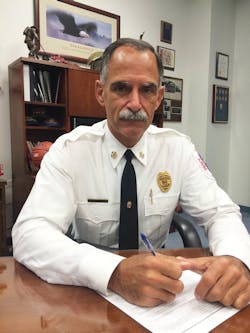Why aren’t bucket brigades the preferred method to muster enough water to fight a fire? Why don’t we still use horse-drawn steam engines? Why don’t we still bite sponges to bust through and filter smoke? Why aren’t sling-packs still the “cat’s meow” for breathing apparatus?
Are you still wearing that tin helmet and riding the back step? I sure hope not. Like most industries, our fire service has many traditions, some of which continue to be “unimpeded by progress,” as they say.
Just this week, a fire service friend posted a picture on Facebook, asking why trash men can still ride the back step, but not us. While I believe his question was half tongue-in-cheek, the other half was a desire to go back to the way it used to be.
Technology is the answer
Educated, intuitive and progressive developments in the technological evolution of our lives answer many of the “whys” above. Technology is the root of almost everything we do, whether in our personal or professional lives. I will readily admit that some of the advances and uses (or lack thereof) of certain technologies have befuddled me; however, for the most part, I believe firmly that technology has improved what we do and how we perform, and has generally helped improve the outcomes of our work.
Bucket brigades were supplemented and then replaced by horse-drawn wagons, which were replaced by steam-driven motorized vehicles, which were ultimately replaced by the expensive, highly complex, technology-based, multi-faceted emergency response vehicles we use today. Breathing apparatus evolved from the hood and sponge to sling-packs to the expensive, highly complex, technology-driven SCBA of today, with mobility-enabled personal alerts, environmental monitoring, and GIS/GPS interfaces being embedded and enabled to track and locate individuals anywhere from a multi-story building to a forest. Our protective garments have evolved from rubber coats and boots with tin helmets to a nearly fully encapsulated ensemble that allows firefighters to do more, go farther and stay in longer than ever before. (Some, of course, will argue farther and longer than is safe—an argument for another day.)
Lore isn’t always reality
Many of these changes have not been popular or come easy, nor have they been inexpensive. Some within our ranks consider the technological advances sacrilegious and impediments to “keeping the tradition alive.” I will argue right here that if “keeping the tradition alive” means firefighters dying needlessly, that is a tradition we must all reject outright.
Like many who joined the fire service, I depended on—or maybe leaned on—the lore of what we do, the stories of tradition and bravado, the firefighters dangling four stories above the blazing inferno to rescue the helpless while “slaying the dragon.” PLEASE. Yes, that lore exists; however, we all know that it is an isolated reality that most of us will never experience. I absolutely do not say this to belittle the true danger and sacrifice firefighters make every day. Let’s just put a little dose of reality on the fire.
To the chagrin of many of my friends today, I find myself asking much more about the science and technology behind “it” than the lore about “it.” I will give you that the lore makes for some good episodes of “Emergency!” or for the younger crowd “Chicago Fire,” and indeed there is MUCH to be learned from experience!
Command and control
Technology has not only impacted our vehicles, our breathing apparatus and our approaches to firefighting and safety, but also command and control. To understand that, let’s talk about the bugles on our collars (speaking trumpets of old). The speaking trumpet was worn around the neck of the officer, giving them the ability to call out orders to firefighters operating over a larger area—the era of no radios, no cell phones, no pagers or Plectrons, no other means of immediate communication other than the basic senses of sight and smell and the ability to speak. The speaking trumpet was the chief’s way to communicate orders.
Two-way radios (UHF, VHF, trunked, analog, digital, etc.) are today’s speaking trumpets. Fortunately (some would say unfortunately), everyone has a radio. We will save arguing the value of EVERYONE having a radio for another time. In the most advanced (and, yes, expensive) systems, firefighters and police officers share radio platforms with emergency management, public health and other partner agencies. Similar to how cell phones have all but eradicated pay phone booths, speaking trumpets became obsolete with the advent of the two-way radio. Displaying bugles on our collar brass is an excellent way of keeping the speaking trumpet “tradition” alive.
Computers and command charts are the last piece I’ll harp on here. One thing you never saw in those old pictures of a chief commanding a scene with a speaking trumpet was a computer or a command chart or system of any kind other than the voice and trumpet. There were probably fewer firefighters operating at most of those scenes, and I’ll argue those times were certainly an example of “not knowing what they didn’t know.” Exponentially more firefighters and community members died in fires during the era of sponges and speaking trumpets.
As such, a reasonable argument is that technology (along with building codes and labor regulations) has been a leading contributor to the reduction in deaths. Going back to the statement “not knowing what they didn’t know,” let’s be more honest with ourselves than most want to be. We KNOW that there is too much going on at the average scene to keep everything in your head. You may THINK you’ve got it, but I call BS. Granted, some minds can hold more and process faster than others, but this isn’t about an individual; it’s about command and control, which is fluid and could change from person to person, depending on the circumstances in your organization and/or at your scene.
I recall one of the first fires I responded to as the emergency manager in Mineral County, WV—a two-alarm warehouse fire. Mineral County has a well-trained cadre of all-volunteer fire/EMS members. My mission as the emergency manager was to ensure the bigger picture of the county’s emergency response and management capabilities could be met, while ensuring that the on-scene incident commander (IC) had everything he needed.
I arrived to a typical scene and asked the first engine driver I found, “Do you know where the command post is?” He did not, however, he pointed to a chief’s pickup. The pickup yielded no results, so I continued my track to find command. The entire time, command was barking orders over the radio, and there were about 15 pieces of apparatus operating. A complete 360 of the building yielded no command post nor any knowledge of where that would be. Hesitant to interfere on the radio, I finally inquired, and to my chagrin, was greeted by the IC walking down a smoky interior corridor to meet me at the outside loading dock. He used no chart, no computer, no napkin, not even his sleeve; it was all in his head, while he operated inside.
I asked a couple questions about resource allocation and needs, and realized there would be few answers that night. Because I am passionate about the need to establish and maintain effective command and control, this is the only place I’ll argue it today. An IC cannot effectively command or control more than their particular first-in unit from an interior IDLH position. Certainly, they cannot control the efforts or maintain the safety of 15 units operating at a two-alarm warehouse fire without a command and control system that goes beyond their head or a napkin (and I have seen the napkin way too many times).
We must use a systematic array of forms and technology that is almost always readily available to ensure that we can accurately and effectively command and control units operating at our scenes. In Prince George’s County, MD, we established one countywide command and control sheet that ensured every IC started with the same tool at every scene. If “command” was established, a command sheet was to be utilized. We even incorporated a “mini” resource-allocation sheet that was easily expanded to a larger sheet should an incident escalate. Further, a mayday procedure checklist, along with extraneous incident checklists, was placed on the backside of every command sheet. If a mayday was called, the IC could flip any command sheet over and not skip a procedural beat.
It is important to note that the use of FEMA forms is a critical step when these incidents begin to expand and transcend work periods; however, the 201 incident briefing form does not provide the average fire chief with the readily accessible information they need to make immediate resource deployment decisions at the early stages of most incidents.
In the past two years, the PGFD began implementing the use of mobile data terminals (MDT) in the battalion chief buggies, and in the past year began extending those to volunteer chief’s vehicles. Due to interface and software conflicts, the implementation was indeed clunky and problematic. Regardless, the MDT did ultimately provide the avenue for dispatchers to easily transmit resource data, including staffing levels, to ICs without saying a word over the radio.
The implementation of automatic vehicle locators (AVL) was another piece of the technological puzzle we implemented. It was not perfect, but it was certainly better than 37 different ways of looking at how “first-dues” should be drawn and quartered. (More on AVL for a future discussion.)
Professionalism first
I recognize the trepidation that many of our traditionalists have in letting go of “what works,” in their eyes. I also recall the charge I gave you several months ago—that we need leaders to be the leader people NEED, which is not necessarily the leader people WANT. No longer can we allow people to consider this “just a hobby” or “part-time work.” This is a profession that requires professional approaches aided by professional standards to ensure professional outcomes. You and the firefighters you work with deserve it. More importantly, the community you serve expects and deserves nothing less.
About the Author

Marc S. Bashoor
MARC S. BASHOOR joined the fire service in 1981. In 2017, he retired as fire chief of Prince George’s County, MD, Fire/EMS, the largest combination department in North America. His progressive community-based approach led to record hiring and a strategic apparatus replacement plan.
Twitter: @ChiefBashoor
Email: [email protected]
